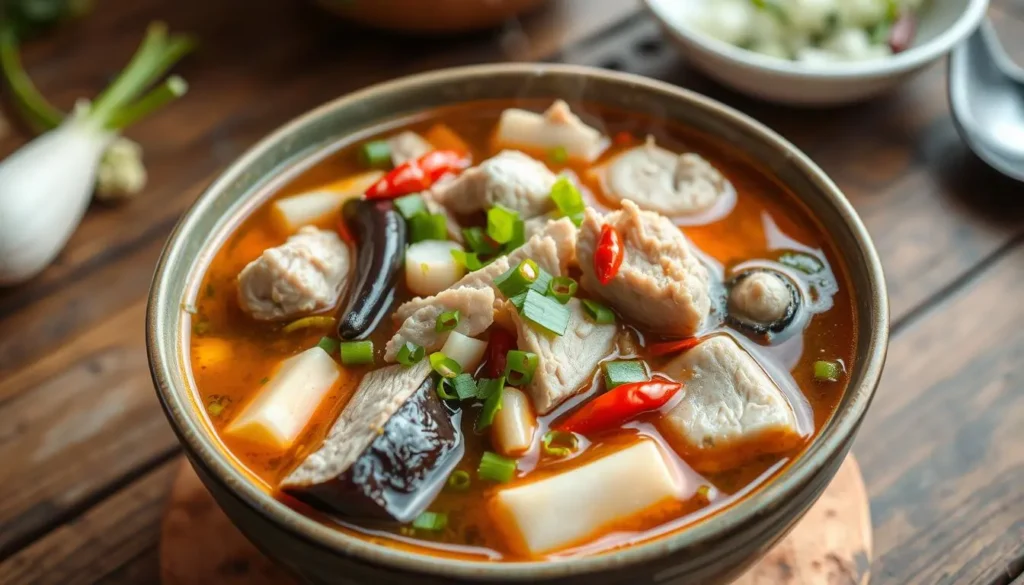Welcome to the world of Sinigang Recipe, a favorite Filipino sour soup. It’s known for its tangy broth, mainly from tamarind. This dish is full of tender meat and colorful veggies. Sinigang is a big hit in Filipino homes and around the world.
It’s the perfect comfort food, warming your heart and belly. It’s a great choice for any meal.
Table of Contents
ToggleKey Takeaways
- The base of sinigang is a sour broth often made with tamarind.
- This recipe is a comforting dish packed with meat and vegetables.
- Sinigang can be made with various proteins and flavor profiles.
- It is a popular choice among food lovers looking for authentic Filipino cuisine.
- Cooking sinigang involves simple steps that showcase the ingredients’ natural flavors.
Introduction to Sinigang Recipe
Sinigang Recipe is a beloved dish in Filipino cuisine. It’s known for its sour and savory flavors. The dish starts with a protein like pork, shrimp, or beef, and fresh vegetables.
These ingredients come from the Philippines’ rich land. This makes sinigang a true taste of local flavors.
To make sinigang, balancing flavors is key. Tamarind is often used for its sourness. But fruits like guavas and green mangoes can also add that special taste.
It takes about 1 hour and 45 minutes to cook pork sinigang. The wait is worth it as the flavors blend together, creating a warm meal.
Making sinigang is a family affair. It’s loved on rainy days or during celebrations. It brings families closer, sharing memories with each spoonful.
The History of Sinigang Recipe in Filipino Cuisine
The sinigang history starts in the Tagalog region of the Philippines. Here, ancient cooking ways thrived. The dish, known for its sour taste, comes from the Tagalog word “sigang,” meaning “to stew.”
Archaeology and old stories show sinigang has been loved for centuries. It has grown to include many local ingredients.
In Filipino cuisine, sinigang shows the importance of sharing meals. It’s more than food; it’s a time for families and friends to come together. The cultural significance of sinigang is huge. It stands for unity, love, and the Filipino way of welcoming guests.
Traditionally, sinigang is made with meat, veggies, and sour ingredients like tamarind. This gives it a special tang. Over time, different versions have appeared, showing the dish’s flexibility.
Now, you can find sinigang with pork, beef, chicken, or seafood. This variety shows how sinigang has stayed popular through the years.
Understanding Sinigang Recipe: What Makes It Special?
Sinigang is a standout in Filipino cuisine because of its unique flavors of sinigang. These flavors come from the sour taste, mainly from tamarind. But, other ingredients like guava and green mango add to its taste too. This shows how different sinigang preparation methods exist across the Philippines.
The dish’s appeal goes beyond its sourness. It’s a mix of flavors that create a beautiful taste experience. The sourness from the tamarind goes well with the richness of the meat. And the freshness of the vegetables makes it even better.
Common vegetables like okra and water spinach add to the flavor and look of the dish. They make sinigang not just tasty but also visually appealing.
The “Sinigang Mix” is also popular. It’s a powdered mix found in Filipino markets. It lets home cooks easily make sinigang. There are different mixes, like tamarind or guava, so everyone can find their favorite.
According to TasteAtlas, sinigang is the world’s best vegetable soup, with a 4.8 out of 5 rating. It’s a comforting dish that many families enjoy. It’s often made at least once a week, bringing warmth and satisfaction to everyone who tries it.
Sinigang Ingredients: What You Need for a Perfect Broth
The perfect sinigang starts with high-quality ingredients. These ingredients make the broth rich and tangy. Knowing the main components can make your pork sinigang recipe even better. Here’s what you need for a delightful broth.
Essential Souring Agent: Tamarind
Tamarind is the key souring agent in sinigang, giving it a unique tang. Traditionally, fresh tamarind is boiled for juice, but tamarind paste is often used for ease. You’ll need about 7 oz. of it, depending on how sour you like it. Other options like guava, kalamansi, or tomatoes are also good, but tamarind is the favorite.
Meat Options: Pork, Beef, and Seafood Variations
Pork is the most common choice for sinigang, but you can try beef, chicken, shrimp, or fish like pompano. Pork spare ribs are a popular choice, and you’ll need about 1.5 lbs. for a rich flavor. The meat is simmered until tender, adding depth to the broth.
Vegetables to Enhance the Flavor
The right vegetables can really boost the flavor of sinigang. Traditional sinigang includes:
- Daikon radish
- Okra
- Long beans
- Spinach (sometimes called water spinach)
- Tomatoes
Adding these vegetables makes the dish healthy and satisfying. They become tender during cooking, enhancing the soup’s acidity.
| Ingredient | Quantity | Notes |
|---|---|---|
| Tamarind Paste | 7 oz. | Adjust for desired sourness |
| Pork Spare Ribs | 1.5 lbs. | Cut into 2-inch pieces |
| Long Beans | 1.5 lbs. | Cut into 1-inch pieces |
| Spinach | 1 bunch | Fresh, to enhance texture |
| Fish Sauce | 2 tbsp | For flavoring |
With these essential sinigang ingredients, you’re ready to make a bold and satisfying dish. It’s a true taste of Filipino cuisine.
How to Make Sinigang Recipe: Cooking Instructions
Learning to make sinigang is all about following each step carefully. This Filipino dish is famous for its sour broth and tender meat. Here are the detailed steps to make this beloved dish perfectly.
Preparing the Tamarind Broth
Choose your souring agent first. Tamarind pods or paste are traditional, but dried packets or sinigang mix are easier to find. Here’s how to start:
- Cook 2-3 pounds of baby back ribs, chopped into 2”–3” pieces, in a large pot filled with water.
- Bring the water to a boil and then add the tamarind. Reduce heat and let simmer for about 30 minutes.
- Add 1 medium diced onion and 1 tomato cut into wedges, allowing them to infuse flavor into the broth.
- If using tamarind mix, follow the packet instructions for water quantity.
Cooking the Meat for Optimal Tenderness
Getting the meat tender is key to a great sinigang. After the initial simmer, cook the meat for an extra 40 minutes. Check the tenderness with a fork. Adjust the heat to keep it simmering gently.
Adding Vegetables at the Right Time
Adding vegetables at the right time is important. After the meat is tender, follow these steps:
- First, add 1 daikon (or taro), and let it simmer for 8-10 minutes until soft.
- Next, incorporate 12–15 pieces of okra and 12 string beans cut into 2-inch lengths. Simmer for an additional 8 minutes.
- Lastly, add 1 bunch of water spinach (kangkong), cooking for another 1-2 minutes until wilted.
Adjust the broth’s sourness to your liking before serving. Enjoy it with rice for a complete experience.
| Ingredient | Quantity | Cooking Time |
|---|---|---|
| Baby Back Ribs | 2-3 pounds | 40 minutes |
| Onion | 1 medium, diced | – |
| Tomato | 1, cut into wedges | – |
| Okra | 12 pieces | 8 minutes |
| String Beans | 12, cut into 2-inch lengths | 8 minutes |
| Water Spinach (Kangkong) | 1 bunch (12 oz) | 1-2 minutes |
| Cooking Time | – | 1 hour |
Variations of Sinigang Recipe: Exploring Different Recipes
Sinigang is a favorite in Filipino cooking, known for its tangy and savory taste. It has many sinigang variations from different regions. Each area adds its own twist, using local ingredients and cooking styles.
Some popular versions include:
- Sinigang na Baboy – a pork-based version that is often favored for its rich flavor.
- Sinigang na Hipon – featuring shrimp, this variation delivers a seafood twist that is light and zesty.
- Sinigang na Isda – typically made with tilapia or bangus, this unique sinigang offers a refreshing taste of the ocean.
- Sinigang inasal – an experimental take incorporating grilled meat adds a smoky depth to the traditional experience.
Regional sinigang recipes differ in protein and souring agents. While tamarind is common, calamansi, green mango, or green tomatoes are used too. This makes sinigang a canvas for creativity, blending tradition with new flavors.
Pork Sinigang Recipe: A Comfort Food Classic
The pork sinigang recipe is a favorite in Filipino homes. It uses tender pork belly, which soaks up the tangy tamarind flavors. This creates a soup that warms both the body and soul.
- 500g pork ribs or pork belly, cut into serving pieces
- 1 medium-sized onion, quartered
- 2 medium-sized tomatoes, quartered
- 2 cups water
- 1 packet sinigang mix (Knorr Sinigang sa Sampaloc is recommended)
- 2 cups sliced vegetables (kangkong, eggplant, radish, okra)
Cooking time is key for the right texture and taste. Start by boiling the pork in water for about an hour until it’s tender. Then, add the sinigang mix to the pot and let it dissolve in the broth.
Next, add the vegetables. Cook them until they’re tender but still crisp. Season with fish sauce or salt to enhance the flavor.
Every bowl of pork sinigang shows the love of family meals. It’s great for family dinners, served with steamed rice. Each serving is about 573 kcal. It’s perfect for a rainy day or a cozy night in, offering a hearty meal.
Tips for Making Authentic Sinigang Recipe at Home
Making authentic sinigang at home needs careful attention to ingredients and flavors. Choosing fresh ingredients over instant mixes can really change the taste. Also, learning to balance flavors makes the dish both comforting and delicious.
Using Fresh Ingredients vs. Instant Mixes
Choosing between fresh ingredients and instant mixes is key for authentic sinigang. Fresh tamarind, veggies, and meats make the broth rich and vibrant. The sourness from fresh tamarind is crucial for the dish’s true taste.
On the other hand, instant mixes can make the flavor one-dimensional. They lack the depth that fresh ingredients bring.
Balancing the Flavors: Sourness and Seasoning
Getting the flavors right in sinigang is all about balance. Start with tamarind and keep tasting until it’s just right. Adding fish sauce boosts the umami and balances the sourness.
Season with salt, pepper, and a bit of lime juice. This ensures every flavor stands out without overwhelming the dish. The aim is to create a memorable, authentic sinigang experience.
Serving Suggestions for Sinigang Recipe
Serving sinigang is as important as the dish itself. Enjoy it hot to feel the warmth of the tangy broth. Pairing it with the right side dishes makes the meal even better, creating perfect pairings that match the sour taste of the soup.
Steamed jasmine rice is a classic choice to serve with sinigang. It soaks up the broth well, balancing the sourness. Adding fried fish, like tuyo, adds a nice crunch and different texture.
Offer a variety of side dishes to go with your sinigang. Fresh veggies like cucumber slices or a simple salad add a refreshing touch. You can also serve a spicy dipping sauce or fermented shrimp paste for more flavor.
Having friends and family over for sinigang makes for a cozy dinner. The dish serves 6-8 people, making it perfect for sharing. Highlighting the perfect pairings of this dish adds to the meal’s enjoyment.
By carefully choosing how to serve and pair sinigang, you make the meal memorable. It’s not just a meal; it’s an experience that brings people together.
Conclusion
Sinigang is a beloved dish in Filipino cuisine, loved by many for its comfort and flavor. Its sour taste, thanks to tamarind, makes it stand out. It’s a favorite in many homes, whether it’s sinigang na baboy (pork) or sinigang na hipon (shrimp).
This sour soup not only fills your belly but also brings families closer. It’s a hit at special events like birthdays and festivals. The mix of flavors and health benefits make it a key part of Filipino celebrations.
Exploring sinigang is a chance to make it your own. It’s a dish full of warmth and love. Let it bring your family together, celebrating your heritage and community with every bite.
FAQ
What is sinigang?
Sinigang is a traditional Filipino sour soup. It’s known for its tangy taste, mainly from tamarind. It often has meat, like pork, and fresh veggies, making it a favorite comfort food.
How do I make a pork sinigang recipe?
To make pork sinigang, start by simmering pork belly with water and tamarind. Then, add veggies like eggplant and water spinach. Cook until they’re tender for a hearty meal.
Can I use other souring agents besides tamarind?
Yes, you can use green mango, calamansi, or santol instead of tamarind. This lets you create different flavors in your sinigang.
What are some typical sinigang ingredients?
Sinigang often includes pork, tamarind, water, and veggies like eggplant, radish, tomatoes, and water spinach.
How long does it take to cook sinigang?
Cooking sinigang takes about 1-1.5 hours. This ensures the pork is tender and the flavors are well mixed.
What is the best way to serve sinigang?
Serve sinigang hot with steamed jasmine rice. You can also add fried fish or crunchy veggies for extra texture and flavor.
Are there different variations of sinigang?
Yes, there are many sinigang variations. You can have sinigang na baboy (pork sinigang), sinigang na hipon (shrimp sinigang), and even sinigang with beef. Each one uses local ingredients and tastes.
Can I use an instant mix to make sinigang?
Instant mixes are convenient, but using fresh tamarind and ingredients will give you a deeper, more authentic flavor.
What are some tips for making sinigang taste better?
For better flavor, use fresh ingredients and adjust the sourness to your taste. Adding umami-rich seasonings like fish sauce or soy sauce can also enhance the taste.
Why is sinigang considered a comfort food?
Sinigang is a comfort food because its warm, tangy taste reminds us of home and family. It’s often enjoyed during gatherings and rainy days, bringing a sense of belonging.







